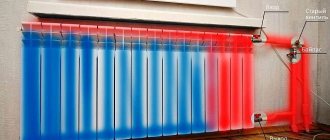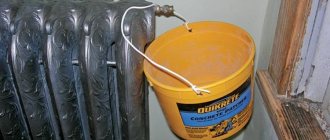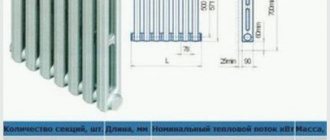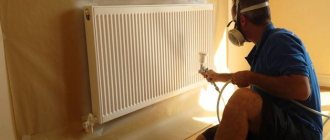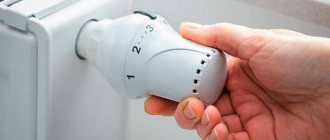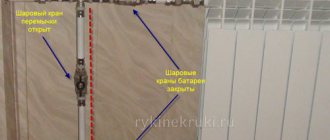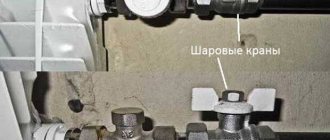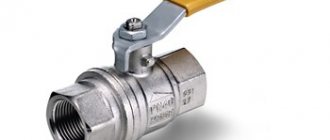Why do batteries heat poorly?
Cold batteries
During the heating season, many radiators do not heat very much, so the room is cold and uncomfortable. There may be several reasons for this phenomenon.
The first is that air has simply accumulated in the battery. This is indicated by a characteristic sound similar to gurgling. The radiator becomes partially cold due to insufficient coolant circulation. In such a situation, it is very easy to blow out the battery. If an aluminum radiator is installed, which has a thermostat, it is enough to open it completely and bleed the air. If there is no thermostat, open the Mayevsky tap or plug.
When opened through the hole, air will escape with a strong hiss. It must be drained until it all comes out and water flows out. A uniform stream will indicate that the air lock has been eliminated and the radiator can be operated in normal mode. On cast iron radiators, special taps are used to bleed air.
The second reason for poor coolant circulation is not air, but a dense plug of scale and large particles that circulate through the heating system along with hot water. Experts point out that even a millimeter thickness of scale deposits reduces the heat transfer of the battery by 15%. Therefore, it is advisable to bleed the system before the start of each season and do it correctly.
How to understand that the reason for the ineffective operation of heating devices in an apartment is accumulated scale? You need to pay attention to the following signs:
- The walls are covered with scale if the riser is hotter than the radiator.
- Feel the radiators in all rooms in the apartment. The different intensity of their heating is a reason for “treatment”.
- Uneven heating of sections of one battery.
What methods exist to eliminate such problems?
How to flush a radiator with your own hands at home
Before you wash a cast-iron battery at home, you need to prepare plumbing tools, old rags and a large container - maybe a bath.
The DIY method for washing cast iron batteries looks like this:
- Cover the walls and bottom of the bath with rags to protect the enamel from scratches during operation. Please note that it is better not to do such work at all in an acrylic bathtub, otherwise it can be hopelessly damaged. Cover the drain hole with a mesh to prevent debris from entering the drain.
- Remove the battery and transfer it to a container. We put a flexible hose on the tap and supply water under pressure inside the radiator. We wash it with plenty of water. From time to time, the battery needs to be turned and shaken so that the dirt is better removed.
- You need to continue washing until the flowing water is clear. Particularly dense blockages in the channels can be removed with a long wire.
Cleaning methods
Self-purge is quite possible, and there are several methods:
- Hydraulic purge.
- Individual cleaning.
- Cleaning with soda ash.
- Pneumohydropulse washing.
- Chemical method.
How are they different from each other? The equipment that is used to perform the operation.
Hydraulic purge
Hydraulic heating purge is the most effective, but also the most expensive method of cleaning the battery. In this case, a mixture consisting of compressed air and water is supplied to the risers using compressors. High pressure allows you to pump in a medium that provokes the detachment of plaque and scale deposited on the inner walls of the batteries.
For cast iron radiators, this is the most effective cleaning. It does not require the use of hazardous chemicals, so it can be called environmentally friendly. But in order to carry out hydraulic purge, it is necessary to disconnect the batteries and take them to a special service center where there is compressor equipment.
Experts use softening agents to speed up the peeling of scale. After the procedure, the radiator is flushed with plain water, after which it becomes clean.
Individual cleaning
Heating flushing
It makes sense to use hydraulic cleaning if all the neighbors in an apartment building simultaneously want to participate in such preventive work. Otherwise, when starting the heating system, the cleaned batteries will very quickly become clogged again, and all the expenses will be in vain. If you need to solve the problem locally, that is, in one apartment, it is better to choose another method - individual washing.
First, the radiator is removed and placed in the bathroom. First, you should completely cover the bathtub with rags. This way the enamel will be preserved and not damaged when flushing the radiators. It is advisable to install a mesh on the drain. It will prevent the formation of sewer clogs.
Cleaning the battery is quite simple. Hot water is poured into one end of it using a hose, and the device is periodically turned over. It is useful to insert a wire or any other means at hand into the body of the battery and try to clean the internal scale with it. The procedure can be stopped when clean water comes out of the opposite end.
Cleaning with soda ash
Soda ash for washing
Cleaning with soda ash is not much different from the method described above. There is only one difference - soda is added to the hot water that needs to be poured into the radiator. The opposite end of the battery is closed and the solution is allowed to stand inside the radiators for a while.
Baking soda softens plaque. But in order to achieve maximum results, it is advisable to knock on the entire surface of the device with a wooden hammer. Then you can drain the water. The procedure must be repeated until clean water flows from the radiator.
Note! Instead of soda, you can use whey or a special cleaner to clean a car radiator.
Pneumohydropulse washing
This type of cleaning is carried out using a special gun. It can be used to clean radiators whose section diameter is no more than 15 cm. Using a gun, you can remove scale at a distance of 50 m and do spot cleaning without dismantling the radiator.
Do I need to purchase professional cleaning equipment?
When deciding whether to purchase professional equipment for cleaning batteries, you must be guided by your personal needs. On the one hand, the work described is a one-time event that is carried out once a year. Therefore, it makes sense to contact the appropriate service department.
If you want to buy a compressor unit and use it yourself, saving on calling specialists, you can purchase a compressor for pumping water at a specialized plumbing store. And for it to work effectively, when purchasing, it is necessary to pay attention to such technical parameters of the installation as operating pressure, volume of water consumption, the ability to adjust water supply pulses and use means for internal disinfection.
Chemical cleaning method
Reagents for chemical cleaning
In many apartments, the quality of the heating system leaves much to be desired. Both pipes and radiators have long been clogged with scale, which cannot be eliminated using the methods described above. What to do in such a situation? Use chemical cleaning. What is it?
Chemicals deal with the identified problem efficiently and quickly. Chemicals are organic acids, composite solutions, alkalis or solvents. You need to work with them extremely carefully, keeping your hands and respiratory tract intact, since all these substances are toxic.
Note! The chemical cleaning method cannot be used for an aluminum radiator, as this may lead to a violation of the seal of the device. But cleaning with chemicals is effective for cast iron radiators.
In order to carry out chemical cleaning, it is necessary to use special equipment - hoses, pumps, containers and chemical mixtures.
Do-it-yourself radiator cleaning
How to wash cast iron batteries from rust is no less important a question than “how to do it.” Conventionally, this process can be divided into two methods: chemical impact on pollution and mechanical.
Household chemicals are most often used as cleaning agents for removing scale, debris and rust.:
- Pipe cleaners, for example, "Mole".
- Chemical solutions containing caustic soda.
- Citric or acetic acid.
- Means for cleaning car radiators.
The work is divided into three stages:
- First, hot water is poured in without any additional means. There should be so much of it in the radiator that when it is shaken, it hits the walls and knocks off the top layer of dirt and scale. After these manipulations, drain the water and proceed to the next stage.
- At this level, you can use special tools. If it is 70% vinegar essence, then you will need one bottle per battery, and add special cleaning agents according to the instructions. After the solution is poured, the battery is closed with plugs and left for an hour or two so that it has time to dissolve the deposits on the walls of the radiator. After the time has elapsed, the chemical solution is drained and the next part of the work begins.
During this procedure, you can lightly tap the radiator with a wooden hammer from time to time to speed up the process of peeling off dirt and rust from the walls of the cast-iron battery.
- The third stage is the final flushing of the radiator. It’s good if the water pressure in the apartment is strong enough, in which case the work will take less time, especially if you pour water directly from a hose without nozzles. You need to pass water through the battery until it comes out clean. After this, the process can be considered complete.
It’s not enough to know how to clean cast iron batteries. If the third stage is carried out poorly and hastily, it may turn out that part of the chemical solution remains inside, which will cause the formation of a new layer of rust. Flushing should continue until the water passing through the heater is completely clean.
Causes and consequences
The reasons for the occurrence of air jams are the following factors:
- Errors were made during installation, including incorrectly placed bends or incorrectly calculated slope and direction of pipes.
- Filling the system with coolant too quickly.
- Incorrect installation of air vent valves or their absence.
- Insufficient amount of coolant in the network.
- Loose connections between pipes and radiators and other parts, which allows air from outside to enter the system.
- The first start-up and excessive heating of the coolant, from which oxygen is more actively removed under the influence of high temperature.
Air can cause the greatest harm to systems with forced circulation. During normal operation, the bearings of the circulation pump are constantly in water. When air passes through them, they are deprived of lubrication, which leads to damage to the sliding rings due to friction and heat or completely damages the shaft.
Water contains oxygen, carbon dioxide, magnesium and calcium in a dissolved state, which, when the temperature rises, begin to disintegrate and settle on the walls of the pipes in the form of limescale. Places of pipes and radiators filled with air are more susceptible to corrosion than others.
Signs by which you can determine whether there are air pockets in pipes and radiators
Due to air in the heating system, the radiators heat up unevenly. When checked by touch, their upper part, compared to the lower part, has a noticeably lower temperature. The voids do not allow them to warm up properly, so the room is less heated. Due to the presence of air in the heating system, when the water is very heated, a noise appears in the pipes and radiators, similar to clicks and water flowing.
You can determine the place where the air is located by ordinary tapping. Where there is no coolant, the sound will be louder.
Note! Before removing air from the network, you should find the cause of its appearance and eliminate it.
Check the network especially carefully for leaks. When the heating is running, it is extremely difficult to identify leaky connections, since water quickly evaporates on a hot surface.
Diagnostics
To understand what caused the drop in radiator efficiency, you need to perform a few simple manipulations.
The first sign that the inner walls of the pipe and radiator are covered with scale will be that the riser along which the coolant moves is significantly warmer than the radiator. The second sign that the pipelines are clogged is different temperatures of batteries installed in the same room or on the same line. The third sign is different heating of sections mounted in one radiator.
Air removal methods
There are heating systems with forced and natural circulation of coolant. In the first case, the liquid flows using a circulation pump, and in the second, due to a certain inclination of the pipes and the pressure in them.
Natural circulation systems
An expansion tank is used to remove air from this type of system. It is installed at its highest point. Most of the air is independently removed through it when the coolant is heated. If air pockets still remain, many experts recommend increasing the amount of fluid in the system by opening the air vents. Thus, the coolant itself will displace the air from the network with movement and pressure.
Forced circulation systems

In systems with a circulation pump, pipes and radiators are located level and without slope. Air vents are used to remove air from them. They are always mounted at the bends and at its highest points, since this is where the accumulation of gases occurs.
Note! If it is not possible to remove air from the system using air vents, then it is necessary to drain all the coolant and refill it.
It is necessary to pour the coolant into the system slowly, since rapid filling causes air bubbles to form. At the same time, you need to remove air from radiators and other elements. The longer the system, the longer it takes to fill it with coolant. If a heated floor is connected to the heating network, then the installation of air vents is mandatory, since the pipes are often located at different heights. You also need to constantly monitor the amount of coolant in the system to exclude the possibility of air getting into it.
Heating water supply sewerage boiler room
We work around the clock throughout:
Moscow region, Vladimir, Kaluga, Tula, Tver
Services
Contacts
- 1 Why do batteries heat poorly?
- 2 Cleaning methods
- 2.1 Hydraulic purging
- 2.2 Individual cleaning
- 2.3 Cleaning with soda ash
- 2.4 Pneumohydropulse flushing
- 2.5 Do I need to purchase professional cleaning equipment?
- 2.6 Chemical cleaning method
- 3 Generalization on the topic
Many people, when preparing for the heating season, prefer to carry out all preventive work themselves. The most important step in this matter is checking the heating devices to identify problems. It is advisable to eliminate them in advance. But to do this, you need to know how to blow out a heating battery yourself by cleaning it from the inside.
Types of air vents
Valves for removing air locks are automatic and manual. The second type of air vents includes Mayevsky taps. They are used not only to remove air, but also to start it up in order to drain the coolant from the system.
Mayevsky crane
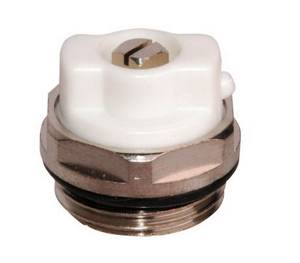
This device is made of brass and has a simple but reliable design. The main parts of the Mayevsky crane are the body and the screw. All valve parts are located as closely as possible to each other, so that the coolant cannot escape outside. Open the tap using a special key, screwdriver or hand.
Before removing air from the heating system, it is necessary to prepare a container for the coolant and tools. Step-by-step instructions for removing air pockets using a Mayevsky crane:
- If the heating system operates using a circulation pump, it should be turned off while the air is being vented.
- Using a wrench, screwdriver or hand, turn the tap 1 turn counterclockwise. You will immediately hear the hiss of air escaping from the radiator.
- As soon as the coolant begins to flow out, it means that the air lock has been removed, the Mayevsky valve is closed back.
Automatic air vent
Automatic air vent VALTEC VT.502
This device independently removes air from the heating system. Installs either vertically or horizontally. Consists of a brass body, float, release valve and articulated arm. To prevent coolant from leaking through it, the air vent is equipped with a protective cap.
Note! Automatic devices are sensitive to impurities contained in water. For long-term operation, cleaning filters are additionally installed in the heating system.
The operating principle is as follows: if there is no air in the chamber, then the outlet valve is closed. As it moves in, the float lowers. Once the chamber is completely filled, the exhaust valve opens and the air is discharged outside. The float then closes the outlet valve again.
Air separator
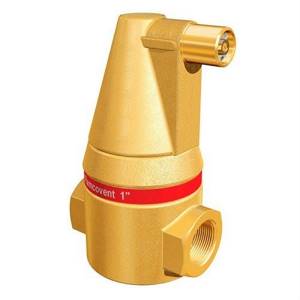
This device consists of a metal body, an air vent, a drain valve and a tube with a mesh. Unlike conventional air vents, the separator itself removes air from the water. As the coolant passes through the mesh, it swirls, causing air bubbles to form. As a result, they rise to the top, and the gases are removed through the air vent. In addition to air, the separator separates sand, rust and other impurities. Remove sludge through a drain valve located outside at the bottom of the housing.
Causes of air locks
Before we figure out how to bleed air from the heating system, let's figure out why it accumulates there. Main reasons:
- carrying out repair work - during disassembly/assembly of elements, air inevitably enters them;
- improper start-up of the heating system in an apartment building - according to the standards, the pipes must be filled with water slowly while simultaneously bleeding out excess air;
- loose fit of parts of the system or poor sealing of joints - the coolant flows out imperceptibly and evaporates, and air is drawn in from outside;
- low pressure in the pipeline, leading to the formation of voids and their filling with air;
- increased amount of oxygen in the coolant - there are always gas bubbles in the water, but if there are too many of them, air pockets can form;
- incorrect connection of the underfloor heating system - arrangement of branches at different heights;
- incorrect operation or absence of an air vent on the battery.
In addition, poor quality radiators can lead to air accumulation. Aluminum devices are affordable and have high thermal conductivity. But the metal actively reacts with water, resulting in the release of hydrogen gas. The problem of rapid corrosion is partially solved by a film that covers the inside of aluminum, but it disappears over time. A more reliable, durable and expensive option is bimetallic batteries, which combine aluminum with steel that is resistant to water.
As a rule, residents of the top floors of apartment buildings face the problem of how to ventilate batteries. When heated, oxygen dissolved in water rises, forming plugs. In private houses with an open heating system, air bubbles freely exit through the expansion tank at the top of the system, so air usually does not accumulate, except in some cases.
Heating water supply boiler room
Heating installation
LLC DESIGN PRESTIGE > https://resant.ru/
Telephone: 8(495)744-67-74
We provide installation services for heating and water supply systems for private country houses, dachas, and organizations. We supply equipment for work at discounts.
Our services:
Heating: > https://resant.ru/otoplenie-doma.html
Installation, design, service repair. Heating by type: autonomous, water, private, wood, individual, gas, natural.
Water supply: > https://resant.ru/vodosnabzhenie-doma.html
Boiler room: > https://resant.ru/kotelnaya-doma.html
For private homes and industrial enterprises. We will install the boiler, distribution modules for heating circuits, and install automation elements for temperature control.
We carry out all work on a turnkey basis. LLC DESIGN PRESTIGE
Home heating systems sometimes need cleaning. You can clean both entire pipes and individual parts. It is important for residents of private houses and owners of autonomous heating cycles to know how to bleed the battery themselves.
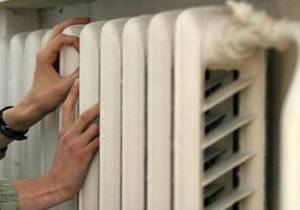
Feeling the batteries
How to bleed air from a battery?
The answer to the question of how to bleed air from a heating radiator depends on the type of air vent installed on it. These devices are necessary to facilitate the removal of excess gas from the system. They should be installed in areas where there is a risk of traffic jams, or, what is even more convenient, on each battery. Possible options:
- Mayevsky tap (manual regulator);
- automatic (float) system.
In addition, a water tap or plug can be installed on the battery.
The Mayevsky valve is a needle-type shut-off valve. It is mounted at the top end of the radiator. If it is necessary to bleed air, it should be unscrewed using a special wrench, which can be purchased at a hardware store, or a regular screwdriver. Some models are equipped with a plastic handle; no tools are needed to open them.
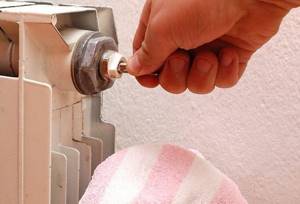
Using the Mayevsky crane to get rid of air pockets in the battery
Stages of air removal work:
- Place a container under the shut-off valve to collect the coolant.
- Smoothly unscrew the Mayevsky tap. At the same time, air will begin to escape, which will be accompanied by hissing. It is necessary to wait until a steady stream of water flows out - this is a sign that the plug has been removed. This usually takes 5-7 minutes.
- Close the valve.
During the process of deflation, water may begin to come out under pressure, splashing in different directions. You should place a rag on the air vent so that the liquid is absorbed into it and flows smoothly into the container. It is worth considering that the water can be quite hot, it is important to avoid getting it on the skin.
Important: Before opening the Mayevsky tap, you do not need to shut off the entire riser of the heating main or wait for the coolant to cool. These actions are not only unnecessary, but also reduce the efficiency of de-airing due to a drop in pressure in the heating system.
If an automatic air vent is installed, then the question of how to properly bleed air from the battery does not arise. This device, which can be of a straight or angled design, operates in a self-contained mode. It is mounted on the radiator strictly vertically or horizontally.
The automatic air vent is equipped with a float that tightly closes the valve if there is sufficient water level in the system. As soon as air accumulates in the battery, the float drops, the hole opens, and the gas escapes. That is, deflation occurs without human intervention.
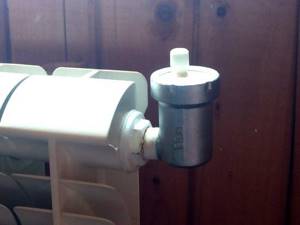
Radiator with automatic air vent
The disadvantage of such an air exhaust device is its sensitivity to water quality. The presence of impurities in the coolant leads to rapid breakdown of the mechanism. In this regard, filters should be used. In addition, you need to periodically replace the O-ring and clean the valve needle. Otherwise, water may begin to leak.
Stub
It is not an easy task to bleed air from a heating battery if there is no air vent and a plug is installed instead. Before starting work, you should block the coolant access to the radiator.
Modern sectional batteries are equipped with top plugs. There is no need to completely remove the fitting. It is enough to carefully turn it slowly, making several turns, and wait until the air comes out. First, all adjacent surfaces should be protected with rags.
It is more difficult to ventilate an old cast-iron radiator, since usually the plug on it is securely fixed with tow and paint. Algorithm of actions:
- Apply a little solvent to the connection between the fitting and the battery. Wait 10-20 minutes.
- Place a bucket under the hole. Place rags on the floor.
- Using an adjustable wrench, unscrew the plug (not completely) until air begins to escape.
- Wrap the thread with sealing material and tighten the plug.
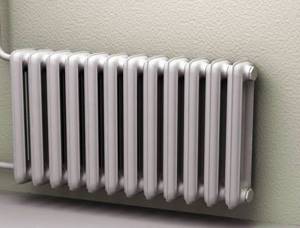
Bleeding air from an old cast iron radiator may require more effort
It is important to do everything carefully. If you do not turn off the water and remove the fitting completely, hot water under pressure will flow out of the hole.
You can determine that the air lock has been eliminated by assessing the temperature of the batteries. Sections that were previously cold should warm up.
Tap
Many old batteries have regular water taps. When you unscrew the valve, water begins to flow from the hole, and with it the accumulated air comes out. You may need to drain several buckets of liquid to remove all the excess gas.
To make the work easier, it is advisable to use a long flexible hose: attach one end to the tap, and lower the other end into the toilet. The valve must be opened as much as possible to ensure a high flow rate of water.
A private house
If an air lock occurs in the heating system of a private home, you need to not only work with each battery individually, but also remove it from the entire system as a whole. The procedure may differ slightly depending on whether you are using a heating system with an open or closed expansion tank. But in general, it comes down to the fact that air is released from the batteries using one of the methods described above.
Air locks reduce the efficiency of heating systems and increase the risk of breakdowns. You can remove excess air from the radiator yourself. The easiest way to do this is if a manual air vent is installed. In the future, it is important to find out the cause of the problem and eliminate it. In difficult situations, it is better to contact employees of housing maintenance offices.
When you first encounter the problem of how to bleed air from radiators, the videos will help you avoid mistakes.
